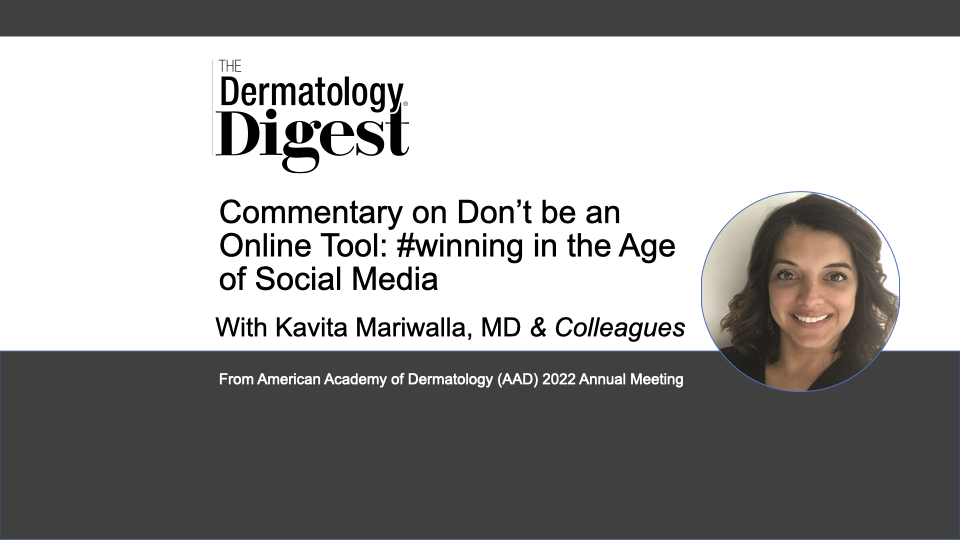Drs. Kavita Mariwalla, Muneeb Shah, and Maxim Polansy discuss dos and don’ts for winning in the age of social media.
“The goal might be to drive traffic into your practice, educate the public at mass scale, be a key opinion leader for other dermatologists, educate residents and medical students, or to highlight offered procedures,” said Muneeb Shah, DO, who co-presented “Don’t be an Online Tool: #winning in the Age of Social Media” with Kavita Mariwalla, MD, and Maxim Polansky, MD, at the American Academy of Dermatology (AAD) 2022 Annual Meeting.
“Whatever the focus, keep the content professional. We represent the entire specialty, and a dermatologist on social media may be the only reference point for the public to understand what dermatologists do.”
According to Drs. Mariwalla, Polansky, and Shah, just as websites became a valuable tool years ago, having a curated social media presence to represent the practice is important today. Not only is it a vehicle for showcasing what the practice has to offer, but it also serves an important service by providing a trustworthy source of accurate information about conditions and procedures.
Social Media Dos and Don’ts
The best performing posts feature the physician, said Dr. Mariwalla, but you need to strike the right balance between personal and professional information.
“Share your thoughts on a topic, but don’t overshare what you are doing outside of work.”
According to all three physicians, posting before and after photos is key when showcasing aesthetic services. If a dermatologist has a niche (e.g., hair loss), targeting content to that problem and making yourself known as a subject matter expert can help grow the practice, Dr. Mariwalla said.
“Incentives can also be used to drive people towards a specific procedure, but offer specials, not discounts!”
Tailor the platform to the local audience, said Dr. Shah.
“Social media, especially Instagram, is like your online resume. The local population will look you up to see what you offer. Using hashtags to your local community and location tags (e.g., #denver with a Denver, Colorado location tag) can help people find you.”
Encourage existing patients to be followers so they will know when a new device or procedure becomes available, said Dr. Shah.
“Networking with local influencers that already have a presence in the community can also bring awareness to your practice.”
Legal Risks and Bad Reviews
Legally, risks are minimal as long as the content is professional and follows HIPAA guidelines, patient images are de-identified, and consent is explicitly documented, said Dr. Shah.
Negative comments and criticisms are another issue, according to Dr. Mariwalla.
“Social media can come with some backlash. Be willing to roll with it. Consider that topics you think are innocuous can create a fury in online comments and that once something is put on the web, it is difficult to take down.”
However, you can take certain actions, she said.
“…posts can be deleted, you can re-post, and don’t be afraid to block people if they are filling your comments with distasteful words.”
Dr. Shah agreed.
“If negative comments are aggressive and do not encourage healthy discussion, it is okay to block or restrict people from commenting.”
To address negative patient reviews, Dr. Mariwalla recommended referring to TripAdvisor to see how hotel managers respond to negative comments.
“I like the line ‘At xxx our goal is for patients to have an excellent and positive experience. Your comment is important to us. We would love to speak with you about this by phone and make sure your experience is a good one going forward.’ This allows readers to know that the person went online without contacting the practice and that we are proactive trying to do the right thing by patients.”
Negative reviews are part of any practice and will happen regardless of how excellent your care is, said Dr. Polansky, whose practice is 90% high volume Mohs micrographic surgery and 10% cosmetic dermatology. A protracted time to achieving the final result is a common source of dissatisfaction among patients undergoing Mohs surgery.
“Delays are inevitable because a skin cancer and subsequent reconstruction can end up larger than expected. So, I tackle the longer waiting time by explaining to patients at the outset that I will provide them with the best surgical outcomes possible, and that may take more time than expected.”
According to Dr. Polansky, it is better to do nothing than to respond to negative reviews while providing an impetus for good reviews with good bedside skills and providing great care.
“Some patients still leave negative reviews, but an overwhelming number of positive responses end up burying the negatives. When patients look at physician reviews and see only five-star comments, they start wondering if the practice is purposefully removing the negative ones.”
“Let positive posts and a high number of repeat surgical patients who know they will get great care speak for themselves.”
By Cheryl Guttman Krader

